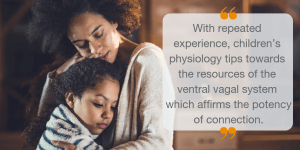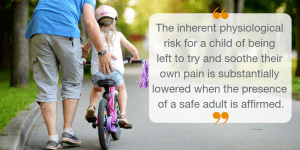
Five activities that promote connected safety for traumatised children and carers
This blog post is written by Dr. Joe Tucci,
CEO of The Australian Childhood Foundation.
Over the last two weeks, I have written two blogs about integrating the work of Steve Porges about safety into practice that centralizes it as a resource for children who have experienced trauma.
In this third and final blog, I describe how the gradual retuning of the physiological circuits that shape a child’s experience of safety progresses to the explicit exploration of safety within the merged relational experiences of the child and the adult. It is my view that the healing power of connected safety emerges as shared experiences arise from synchronous engagement by protective adults with children in their care which are then followed by acts of reciprocal reflection and meaning-making.
Activities that invite connected safety
Connected safety is at the heart of healing. It occurs when, as practitioners, we actively direct opportunities for playful exchanges which promote matched behavioural patterns between a child and an important adult, like a carer or parent. As it unfolds, children and carers are supported to engage in acts of turn-taking and mutual recognition of each other’s responses.
Each small parcel of intervention ends with a cognitive reflection exercise that attempts to give collective meaning to how connected safety is experienced in the bodies and minds of the adult and child. This narrative resource is logged as a reminder to be used at times of relational disruption and misalignment. The bigger the bank of experiences, the greater the predictability of the shared experiences of relational safety in the child and the adult.
The following five activities are examples of how joint experiences of play that combine sensory, narrative and metaphorical dimensions promote the shared movement underpinning connected safety.
You and me on a treasure hunt…
In a room, the therapist creates imaginary landmarks that need to be navigated to find a hidden treasure. Each landmark is represented by a sensory object that resembles the features of that point in the landscape. Vines in a jungle are represented by soft ropes. Muddy flats are represented by wet sand. Windy plains are represented by a fan blowing into a corner of a room.
A land of bubbles is represented by balloons. The child and adult are invited to traverse each of the landmarks and at every point take notice of how they are keeping themselves safe. They are also asked to describe to each other how they are helping each other to stay calm and keep on track. They are encouraged to talk about how their bodies feel as they approach a new challenge and how safety helps them to take each step and find the treasure.
Joining up the stars in the sky…
In a darkened room, the child and the adult are given a flashlight each. The child is asked to make stars appear on the ceiling by switching the torch on and off. The adult is invited to join up the stars in the sky created by the child by matching the rhythm of the stars’ twinkles. The child and adult take it in turns to create different twinkles rhythms (slow, fast, dancing, skipping) and repeat what the other has created.
As the child and adult share in matching their experiences, the therapist asks them to describe how the rhythms are different and feeling words that best describe them. They explore how they can make their bodies synchronise in real life – at moment s of fun, safety, calm.
This is an activity that explores the embodied experiences of co-operative social engagement systems of the child and the adult.
Sandy togetherness…
The child and the adult are given a container with sand and bucket each. They are guided to pour the sand over each other’s hands, draw collaborative pictures in the sand with their fingers, make symbols in the sand that represent shared experiences of feeling safe. As they do this, they are invited to reflect on the fun that they are having now. They trace fun and safety through stories that they can tell to each other.
Feel the music…
The child and the adult listen to different examples of classical music. The music chosen for this activity span a range of tones, rhythms, and arrangements. The child and the adult are asked to take it in turn to choose tracks which represent to them a feeling, such as happy, sad, excited, scared, lonely, proud, frustrated, surprised, safe. The child and adult are invited to describe the dimensions of the music which they believe characterises the feeling. For example, fear can be represented by loud, low notes with deep vibrations.
Safety can be represented by violins playing softly in harmony with other instruments. The feelings that the music evoke are traced into bodies of the child and adults with questions that explore the location and reaction toeach track. The child and adult explore how safety can be found in many of the tracks if you listen deeply enough.

Squiggle and giggle…
The child and the adult are provided with a tray containing coloured shaving cream. The child and the adult take it in turns to make different shapes which have to be matched by the other. They compare their shapes. They reflect on how they can best work together to make each other’s shaving cream shape be as identical as possible.
They choose a shape that represents a shared memory or feeling of safety they can both recognise. They finish the activity by creating a shared picture which explores children and adults feeling safe together.
In all these examples, children and adults are given the opportunity to share internal states reflective of an open and active social engagement system. This is represented in reciprocal exchanges filled with fun. Children are led through what Porges has increasingly referred to as “neural exercises” embedded in such play (Porges and Carter, 2016). Caring adults support the activation of mobilized states at the very border of relational safety.
Soft tones of voice shared movements, mutual gaze recruit the child’s physiology towards down-regulated states of calm and interdependence. This back and forth exposes children’s ‘fight/flight’ reactivity to the influence of the social engagement system offered by carers. With repeated experience, children’s physiology tips towards the resources of the ventral vagal system which affirms the potency of connection.
Connected safety is the theme that draws a relational line which joins their respective physiology and cognition. Narratives of mutuality become a base on which an articulated sense of safety is autonomically known and understood. It is available to be used as a resource when perceived or real threat may re-emerge.

Connected safety builds on repetition. It sets up a “neural expectancy” (Porges and Carter, 2016) in children that a reliable attuned adult can regulate their activated states of distress and fear. The inherent physiological risk for a child of being left to try and soothe their own pain is substantially lowered when the presence of a safe adult is affirmed.
The predictability of responses by adults to the child’s physiological and psychological needs makes clear to the child the intent of the adult to act protectively. The games and activities are the sparks transforming the future relational experiences for both child and adult.
Connected safety is a biological imperative.
Porges has often repeated, as an eloquent conclusion to his years of research, that connectedness is a biological imperative (Porges and Carter, 2016). It serves significant survival functions. It is resourced by mammalian neurophysiology which has evolved to ensure that such inter-dependence is achievable.
Underscoring this simple truth is an even more obvious one. Safety, as the emergent property of an interwoven physiology between humans that regulates and facilitates growth and restoration, is equally a biological imperative. Deep relational safety is certainly the means through which children who have suffered abuse and violence come to settle and find the comfort and love they need to recover from its traumatic effects.
Realising such deep connected safety is both the intervention and the end goal of therapy with traumatised and vulnerable children and the important adults who care, educate and support them.
References
Porges, S.W. and Carter, S. (2016). The neuroscience of safety in treatment – Clinical applications of the Polyvagal Theory. Masterclass Presentation at the Second International Childhood Trauma Conference, Australian Childhood Foundation, Melbourne.
Acknowledgement
The three blogs in this series are derived from a chapter that I wrote with Angela Weller and Janise Mitchell at the Foundation and published recently in an edited compilation of material translating the Steve Porges work on polyvagal theory into practice. The reference for this chapter is as follows:
Tucci, J., Weller, A. and Mitchell, J. (2018). “Deep” safety for children who have experienced abuse: Application of Polyvagal Theory in therapeutic work with traumatised children and young people. In S.W. Porges and D. Dana (Eds.) Clinical Applications of the Polyvagal Theory: The Emergence of Polyvagal-Informed Therapies, (pp. 89-105). New York: W.W. Norton and Company.
